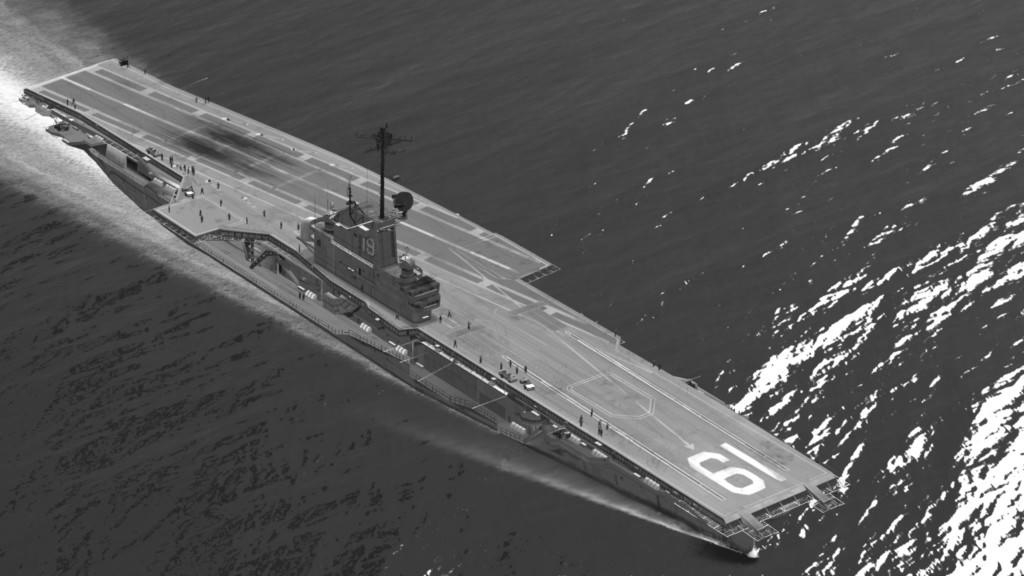
Modelling is almost completed and it seems appropriate to record the various features and reasons for opting for particular approaches.
DETAIL
The aim was to create a carrier to be used as the preferred choice when at sea. It was to look and feel right and contain plenty of detail so that the navy pilot could suspend disbelief for a brief, pleasurable, moment. USS Hancock CVA-19 circa 1970 was arbitarily chosen as the model and probably the only accurate item in the model is the number '19'. Everything else is, of course, vertices, edges, faces and pixels. However, it is hoped that enough has been added to make the pilot think he's on the 'Fighting Hanna'.
TEXTURES
Large maps were used wherever possible. There are very few plain surfaces, most textures were mapped onto textured areas to give variation in hues and tones.
WEATHERING
Usually the mapping underlayers were toned and smudged a little then another layer of varied hues and opacity was overlaid. More layers of dirt or rust or abrasion were then added.
LIGHTING
Some upper surfaces and most top edges were lightened to emphasise lighting. Shadows were added widely even though the IL2 engine is known to deal well with lighting.
LADDERS, RAILS AND NETTING
Many features were created using transparencies to add to the complexity of the model. Safety netting was liberally added around the deck edges.
DOORS
Planes were created with associated UV maps and made on a relatively large scale in the texture map then scaled on the island.
HANGERS
Trapezoidal spaces were cut into the hull and a background image created with a transparent plane containing figures in front to give a psuedo 3D effect.
DOWNPIPES
Some downpipes were added to the island and hull. To save vertices the pipes were simple inverted V shapes with no back planes; 32-sided cylinders would be better but we'll wait for 128-bit PC power.
RIGGING
Straight lines were not used for rigging because it was thought that they often look too rigid. Blocks were suggested by means of triangular objects at the ends of the rigging; the eye and the brain does the rest.
RADAR
Plenty of small scale grids and transparencies used to give a complex feel. Would be nice to have rotating radar but there was insufficient time for investigation. (I think the radar-guided gun directors from diving hawk/western0221 still rotate and follow aircraft though).
WATER SPOUTS
Water waste flows were added using a transparent map on a simple form. the z-buffer shimmer was accepted as a substitute for animation.
STEAM CATAPULT
A hook was created deep inside the hull for vapour but the effect was too unrealistic. Another method was to create 6x planes close together to give a Z-buffer shimmer but this was too static because it needed semi-transparency for full effect. Would be nice to have.
LANDING AID
A self-illuminating FLOLS was attempted with no success. A simple, non-working transparent FLOLS was created instead.
ANCHORS
Borrowed from Asheshouse, thanks.
GUNS
All but 4x 5" guns were removed as was appropriate for the era. The empty spaces were filled with stowage boxes, communications points, floats and emergency points.
SMOKE
Smoke was omitted because it was thought to detract from the realism. For example, smoke is hardly ever seen on ships of this era under way. Similarly, there is no need of a flag. (Vertices saved).
HULL
The underwater part of the hull has been removed because the ship is not going to be attacked, nor is it going to sink, nor is anyone going to sit there and watch it sink. (More vertices saved for something else).
DAMAGE
No damage models have been included; this carrier has not been constructed for use as a target. Aircraft collisions with radar mast, island and so on are rare and no time was spent constructing or utilising existing collision boxes.
LOD
The levels of detail are still being considered.
 Author
Topic: USS Hancock CVA-19 (Read 29505 times)
Author
Topic: USS Hancock CVA-19 (Read 29505 times)


